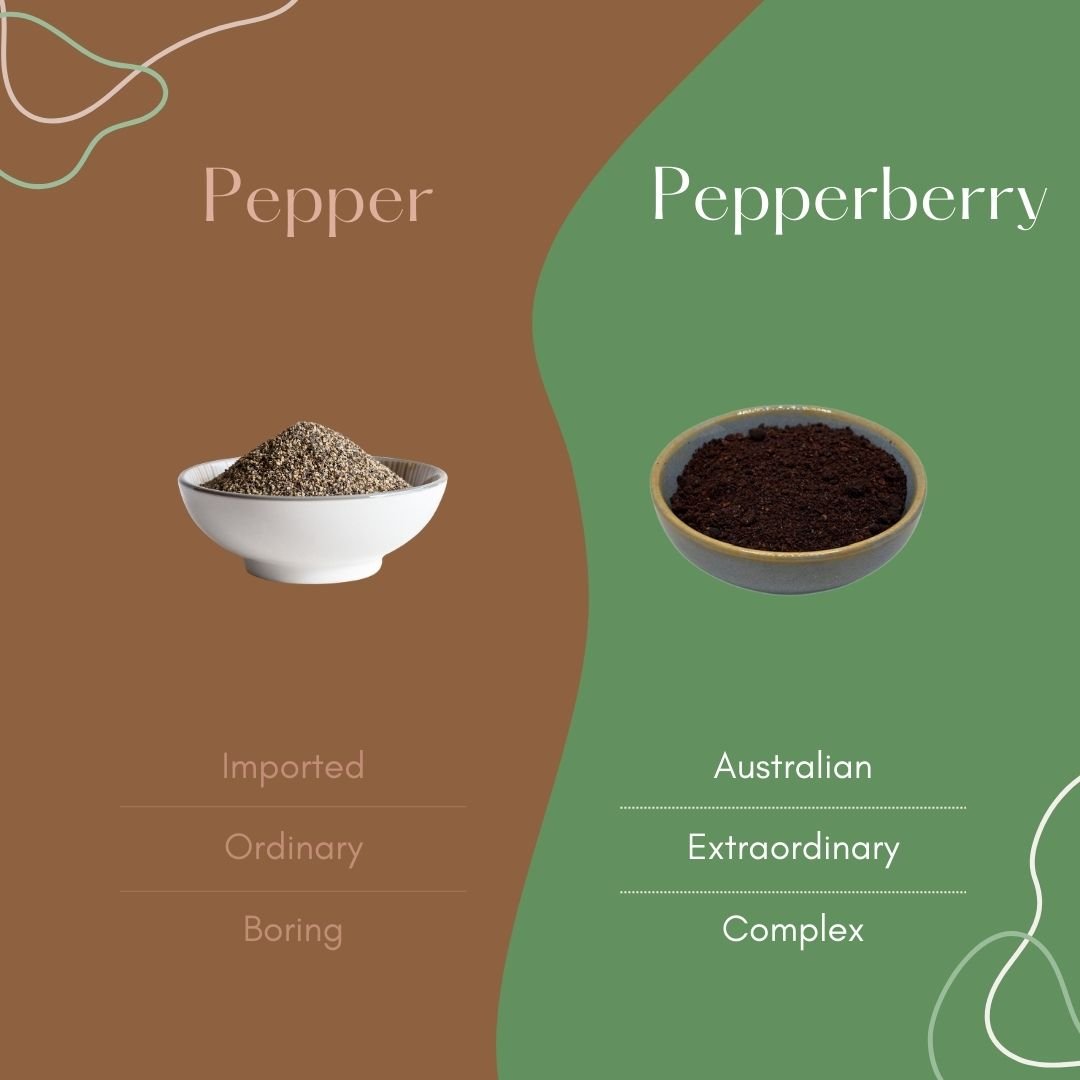
Pepper or Pepperberry: Unveiling the Differences
Share
In the culinary world, spices play a pivotal role in enhancing flavours. Two such spices, black pepper and pepperberry, often cause confusion due to their similar names. However, they differ significantly in origin, flavour, and culinary applications. Understanding these differences can boost your culinary creations and introduce you to unique Australian native ingredients.
Origins: Black Pepper vs. Pepperberry
Black pepper (Piper nigrum) is a flowering vine native to South India. Cultivated extensively in tropical regions, its unripe green berries are harvested and sun-dried until they turn black and wrinkled, becoming the familiar spice found in kitchens worldwide.
In contrast, pepperberry, specifically the Tasmanian pepperberry (Tasmannia lanceolata), is indigenous to the cool temperate rainforests of south-eastern Australia, including Tasmania. This evergreen shrub produces small, round, deep purple to black berries that have been utilised by Indigenous Australians for centuries, both as a culinary spice and for medicinal purposes.

Flavour Profiles: A Comparative Analysis
Black pepper is renowned for its sharp, pungent flavour with a hint of heat. It's a versatile spice, enhancing a wide array of dishes globally. The spiciness of black pepper is due to the compound piperine, which stimulates the taste buds and adds depth to culinary creations.
Pepperberry, on the other hand, offers a unique taste experience. When dried, it exudes a woody fragrance with subtle pepper and dry, mildly spicy notes. The initial taste is woody and camphor-like, followed by a sharp peppery flavour and lingering heat. Notably, pepperberry's spiciness can be up to four times that of black pepper, and its heat builds gradually, peaking about five minutes after consumption. Additionally, when cooked, especially at high temperatures, the spiciness of pepperberry diminishes, highlighting its fruity undertones.
Culinary Uses: Traditional and Contemporary Applications
Black pepper's versatility makes it a staple in various cuisines. It's used in everything from seasoning meats and vegetables to enhancing sauces and soups. Its robust flavour profile complements both savoury and, occasionally, sweet dishes.
Pepperberry, being a native Australian spice, has found its way into both traditional Indigenous and modern Australian cooking. Its intense and nuanced flavour makes it suitable for a variety of applications:
As a Condiment: Dried pepperberries can be cracked directly onto dishes, offering a potent alternative to regular black pepper. Due to its intensity, it's advisable to use it sparingly.
In Sauces: Incorporating pepperberry early in the cooking process can add richness and complexity to sauces. As the heat reduces during cooking, the berry's fruitier qualities become more pronounced, allowing for generous use without overwhelming the palate.
Culinary Pairings: Its unique flavour profile pairs well with mild cheeses, making it a popular addition to cheese boards. It's also incorporated into cheeses, providing a spicy contrast to creamy textures.
Dry Rubs: Used as an Australian alternative in dry dark meat and light meat as well as fish rubs, bringing a hint of Australia to m ore traditional rubs. Check out Terrablend’z range of BBQ Rubs and Seasonings incorporating Pepperberry!

Health Benefits: Beyond Flavour
Black pepper is known for its antioxidant properties and its ability to enhance digestion. Piperine, the active compound in black pepper, has been studied for its potential to improve nutrient absorption and possess anti-inflammatory effects.
Pepperberry is particularly noteworthy for its health-promoting properties. It's packed with antioxidants, boasting levels up to four times higher than blueberries, making it a potent superfood. These antioxidants help combat oxidative stress and may reduce inflammation. Traditionally, Indigenous Australians have used pepperberry for its medicinal properties, including treating skin disorders and stomach ailments.
Pepper or Pepperberry: Frequently Asked Questions
What is the difference between black pepper and pepperberry?
Black pepper comes from the Piper nigrum vine native to South India and is known for its sharp, pungent flavour. Pepperberry, or Tasmanian pepperberry (Tasmannia lanceolata), is indigenous to Australia and offers a unique woody and camphor-like taste with a sharp, lingering heat.
Can I substitute pepperberry for black pepper in recipes?
Yes, but with caution. Pepperberry is significantly hotter than black pepper, so it's advisable to use it sparingly and adjust according to taste. Additionally, cooking reduces its spiciness, bringing out its fruity notes.
Where can I buy dried Tasmanian pepperberry?
You can purchase high-quality dried Tasmanian pepperberry from Terrablendz. They source their products from Australian farms, ensuring authenticity and quality.
What are the health benefits of pepperberry?
Pepperberry is rich in antioxidants, containing levels up to four times higher than blueberries. These antioxidants help combat oxidative stress and may reduce inflammation. Traditionally, it's been used to treat various ailments, including skin disorders and stomach issues.
How should I store pepperberry to maintain its freshness?
Store dried pepperberries in an airtight container in a cool, dark place. This will help preserve their flavour and potency for an extended period.
Pepper or Pepperberry: Embracing the Unique Qualities of Pepperberry
While black pepper remains a global staple, exploring native spices like the Tasmanian pepperberry can add a distinctive Australian flair to your culinary repertoire. Its unique flavour profile and health benefits make it a valuable addition to any kitchen. To experience the authentic taste of this native spice, consider sourcing dried Tasmanian pepperberry from Terrablendz, where quality and sustainability are paramount.
Further Info
Find your Australian Native Herbs and spices below and start exploring!
Check out some more info on Tasmanian Pepperberry here! Native Pepper Australia: Tasmanian Pepperberry.
For more Australian Native Herb and spices information, additional Australian Native Recipes and Cooking ideas please subscribe at www.terrablendz.com.au

Dried Tasmanian Pepperberry (Tasmannia Lanceolata)

Terrablendz Australian Native Herb Collection Pack
Additionally, for more information about Australian Native Foods and recipes check out the below links.
Additional Information
Easy Australian Pulled Pork Tacos with a Native Twist
What Is Tasmanian Pepperberry Good For?
Pepperberry Chicken and Rice Bowl
How do you use Saltbush Seasoning?
Poultry Rub for Chicken: Dusty Chicken with Australian Natives
Finally, reach out, follow and subscribe on the below.
